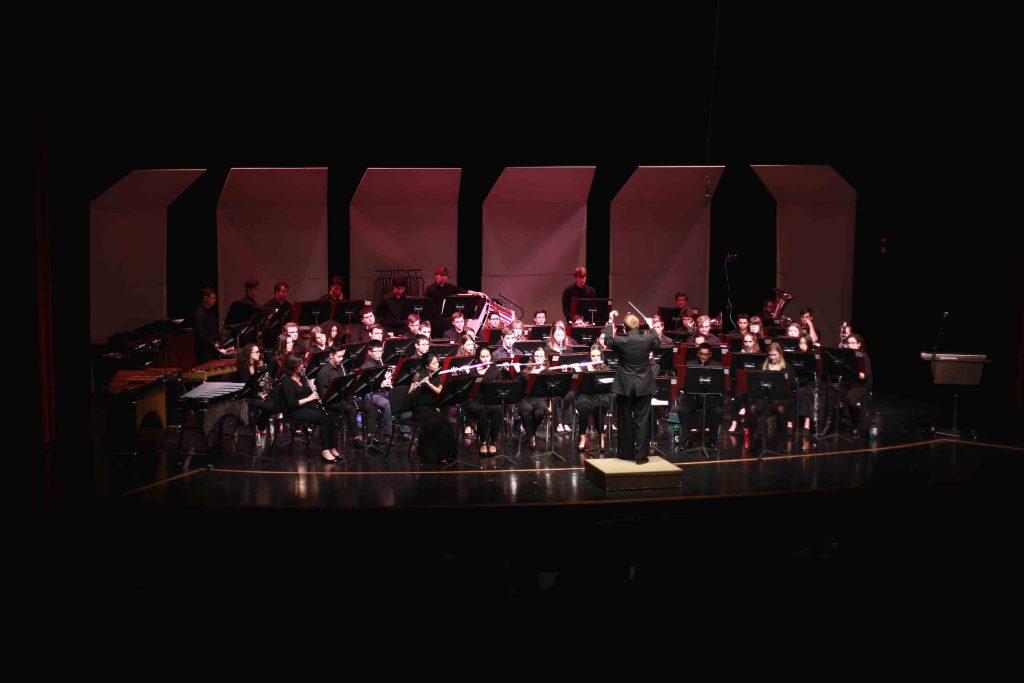
Though there were no dancers on stage, the Anderson Center Chamber Hall was filled this Saturday with music from ballets and other dances in the Binghamton University Wind Symphony’s presentation of “Ballet and Beyond.”
Classical ballet rhythms and sounds twirled and swayed across the stage in the opening number, “Pineapple Poll: Suite From the Ballet,” composed by Arthur Sullivan and arranged by Charles Mackerras. This neoclassical ballet went through four movements: “Opening Number,” “Jasper’s Dance,” “Poll’s Dance” and “Finale.” The Opening Number starts with a strong, bold brass section and is excited throughout the movement, leading up to the much smoother style of “Jasper’s Dance.”
The slower and calmer “Jasper’s Dance” is followed by the livelier, energetic “Poll’s Dance,” creating a juxtaposition between the two. “Finale” ended the suite on a powerful note, demonstrating the skill of the Wind Symphony early.
In “A Short Ballet for Awkward Dancers,” a comedic piece composed by Herbert Hazelman and led by music department lecturer and conductor Daniel Fabricius, each of the four movements comically convey a ballet dancer performing with a specific injury or problem specified in the movement’s title, such as “Waltz for People with Slipped Discs.”
These movements incorporate various classic comedic tools, like slapsticks and slide whistles to create a droll and sometimes even deliberately ridiculous atmosphere. The piece itself, as Fabricius put it in the program notes, is “pure satire.” Fabricius then continued conducting with the next number titled “Chorale and Shaker Dance,” composed by John Zdechlik. The Wind Symphony played through this jazz-influenced piece before exiting offstage for an intermission.
The high-pitched winds rang through the air as the Wind Symphony put on a display of Ashkenazi Jewish culture from Eastern Europe. “Wedding Dance,” composed by Jacques Press, arranged by Herbert Johnson and edited by Frederick Fennell, traveled across the world by way of the Jewish diaspora, calling upon Judaic music and dance traditions. The woodwind sections, particularly the clarinets, were noteworthy in this piece for demonstrating the signature fast-paced style of klezmer music and dance. With this piece, the University Wind Symphony transformed the Chamber Hall into a traditional Jewish wedding.
With an anecdote about the popularity of tango in Finland, the stage became a tango dance floor as mystery and suspense filled the air. With Michael Gandolfi’s “Vientos y Tangos,” the University Wind Symphony, led by Fabricius, delivered a Latin experience, achieving the signature romantic undertones prevalent in much tango music. Traditional tango instruments were used in the percussion section to establish the atmosphere and at one point the drummers clapped a tango beat to keep the rhythm of the piece.
The University Wind Symphony traveled to a different part of the world to the sixth and final piece: “Armenian Dances, Part 1,” composed by Alfred Reed. The five-part movement took the audience on a journey through Armenian folk music and dance, both rich areas seldom explored by average Americans.
Fabricius shared that this piece was his favorite of those on the program.
“The Armenian Dances is one of my favorites, and although I liked everything on the program, that’s one of my real favorites,” he said.
At the close of the concert, the Chamber Hall filled with thunderous applause for the performers and conductors.
“The students played really well and it’s about what we want, and we want to have a culmination of the work that they’ve been doing and make sure that everything is nailed down for the performance,” Fabricius said. “And it seemed like the audience liked it too.”


